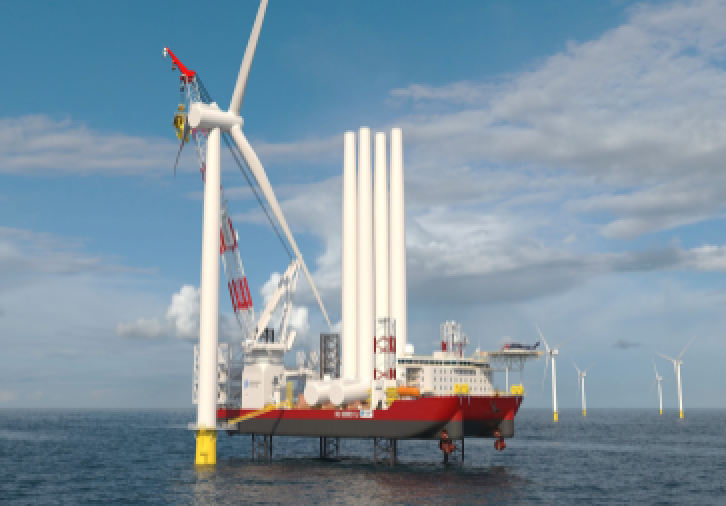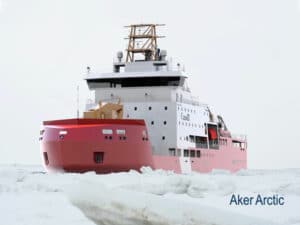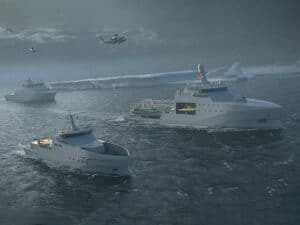
Offshore vessel construction: Waiting on the wind
Written by Nick Blenkey
Dominion Energy's Charybdis promises big capabilities but represents a $500 million investment. (Credit: Dominion Energy)
Other Options
Houston-headquartered Friede & Goldman Ltd (F&G), long a leader in jack-up technology, has come up with a couple of Jones Act-compliant solutions that are not based on based on the use of a large conventional WTIV designed to transport turbine components as well as install them. Instead, both proposals are based on the idea of performing the installation using a relatively small F&G designed jack-up platform.
In a solution called NewWindShape, components are brought to the jack-up using standard ocean barges as feeder vessels and, as in other feedering based systems, the jack-up does not need to be Jones Act compliant.
A key component of the system is the Tetrahedron model 65 crane. Developed by Netherlands-based Tetrahedron BV, it is able to achieve lifting heights of 200 meters above the still water level and has a 20 MW turbine installation capability. As its name implies the crane has a tetrahedron shape, designed to take the increased side loads often seen with afloat load transfers.
Tetrahedron BV has also developed the smart hoist system, said to offer “unparalleled” lifting speeds. In addition, a “rigging-on-deck” principle is used to eliminate the need for a heavy tool to clamp on the top-flange of a tower segment. All of these combined with the crane’s side load stability, are said to enable turbine component transfers from barge to platform without expensive active motion compensating systems.
An alternate F&G concept, called Bargerack, eliminates motions between the self-elevating installation vessel and the feeder vessel by using a trussed rack fitted to the transom of a relatively small self-elevating vessel. The feeder barge, with its turbine component cargo, is floated over the submerged rack. Once the feeder barge is secured, the self-elevating vessel uses its onboard jacking system to elevate, while also lifting the feeder barge completely out of the water.
From this position, the main crane installs the wind turbine components directly from the stationary feeder barge onto the turbine foundation. After turbine installation, the self-elevating unit jacks down into the water, submerging the rack, and re-floating the now empty feeder barge.
Foundations
Regardless of how they’re installed, wind turbines need foundations, and Great Lakes Dredge & Dock Corporation (GLDD) has engaged Ulstein Design & Solutions B.V. to design what will be the first U.S.-flagged, Jones Act-compliant, inclined fallpipe vessel for the subea rock installation required for wind turbine foundations and scour protection.
GLDD says the vessel represents a critical advance in building the future of the new U.S. offshore wind industry, which will include establishing a U.S.-based rock supply chain network spanning eastern seaboard states with active offshore wind leases.
Pending federal permitting and regulatory approvals as well as a final investment decision, the vessel will be operational as early as first quarter 2024, to coincide with major offshore wind project construction timelines.
GLDD says the vessel will “be built on the Gulf Coast” and, in May, gave Ulstein the go ahead to carry out the integration engineering of the vessel and to start detail design.
Floating Wind
Installation of U.S. floating offshore wind farms is yet a while away. In terms of what this will mean for U.S. shipyards about all that can be said is that, although the floating foundations may be “vessels,” they don’t transport anything so would not need to be U.S.-built. Likewise, installation (i.e. towing them out and anchoring them) will likely be well within the capabilities of existing U.S. tugs and offshore service vessels.
In Service Wind Farm Support
Once in service, wind farms will require the support of two categories of vessel that are somewhat different than those used in the offshore oil patch: CTVs and service operation vessels (SOVs).
A recent Marine Log webinar, available on our website, “Trends in Vessel Design and Offshore Wind Maritime Support,” gives some good insight into what’s trending in the CTV sector.
Thus far, the only announced plan for a Jones Act SOV is the vessel that Edison Chouest Offshore (ECO) is to build for long-term charter to Ørsted and Eversource.
It will be engineered, constructed and operated by ECO as an integral part of the operation and maintenance of the planned Revolution Wind, South Fork Wind and Sunrise Wind offshore wind farms and will be utilized during the operation and maintenance phases of the projects, serving as an at sea base of operations to accommodate and transfer technicians, tools and parts to and from the individual wind turbine generators.
The vessel will be built at a combination of Edison Chouest’s shipyards in Florida, Mississippi and Louisiana, creating well over 300 new construction jobs.
The vessel is being built to a special-purpose design with focus on passenger comfort and safety, enhanced maneuverability and ship motions, extended offshore endurance and reduced emissions.
What’s the price tag for this kind of capability? According to the most recent MARAD update on pending Title XI ship financing program applications, $69,029,000 in guarantees are being sought for the ship, with the vessel’s total cost being given as $81.2 million.




